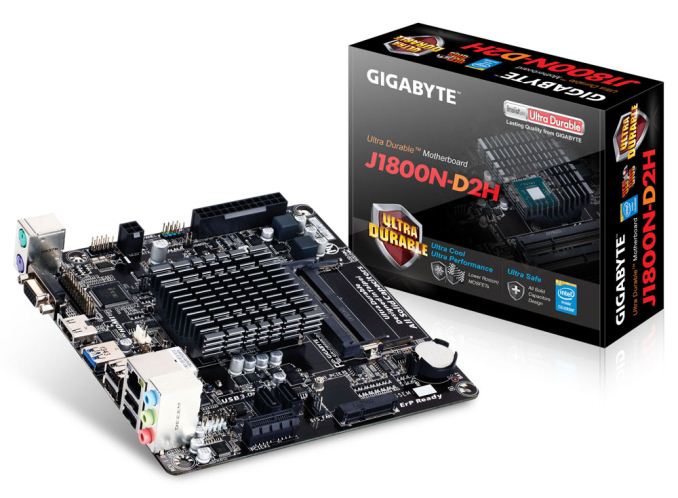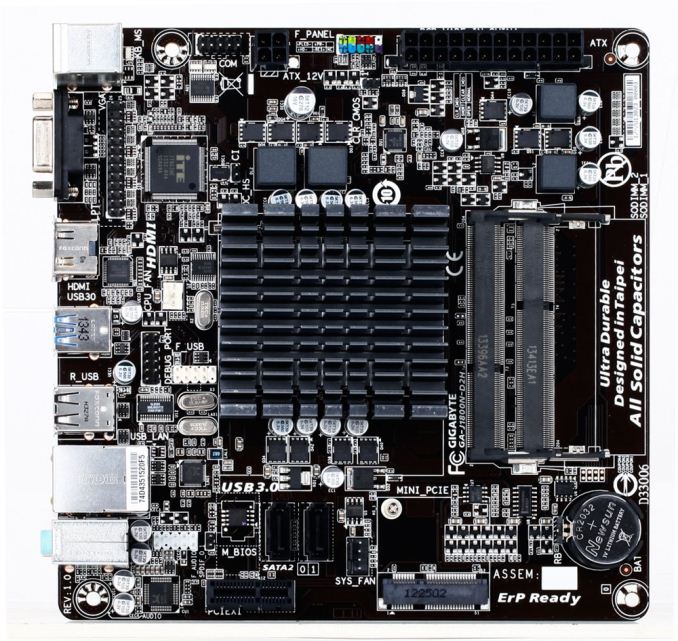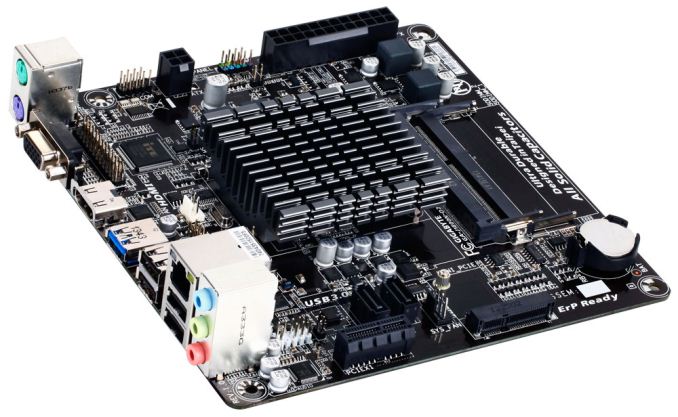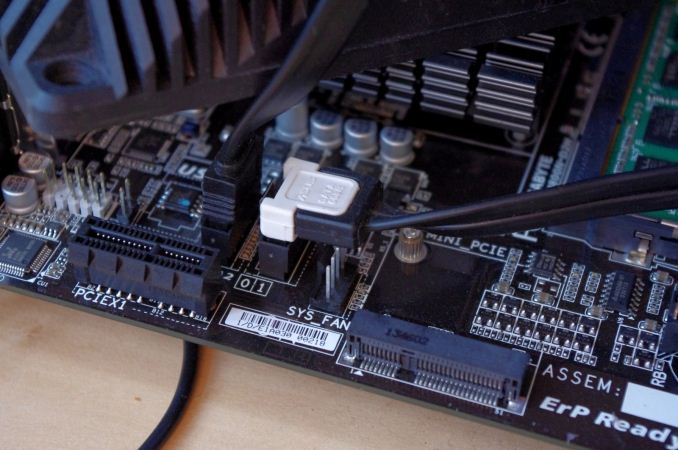GIGABYTE GA-J1800N-D2H Review: Dual Core Bay Trail-D at $69
by Ian Cutress on December 26, 2014 11:00 AM EST- Posted in
- Motherboards
- Intel
- Bay Trail

Our recent review of the HP Stream 11 by Brett Howse, featuring a dual core Bay Trail-M, made me wonder about the utility of such a desktop system with Bay Trail-D. Despite testing the J1800N-D2H earlier in the year but not writing a review, I thought it best to polish of the data and see if it still relevant alongside the $200 offerings and worth the potential extra cost for a full build to fill out a motherboard in exchange for the potential extra functionality (2T2R WiFi rather than 1T1R, SATA drives rather than eMMC).
The 10W Celeron J1800 SoC sits at the bottom of Intel's Bay Trail-D range, featuring a dual core with a 2.41 GHz base allowing a turbo mode up to 2.58 GHz with dual channel memory at DDR3-1333.
| Intel Bay Trail-D | ||||||
| Celeron J1750 |
Celeron J1800 |
Celeron J1850 |
Celeron J1900 |
Pentium J2850 |
Pentium J2900 |
|
| Cores | 2 | 2 | 4 | 4 | 4 | 4 |
| Threads | 2 | 2 | 4 | 4 | 4 | 4 |
| Base Frequency / MHz | 2410 | 2410 | 2000 | 2000 | 2410 | 2410 |
| Turbo Frequency / MHz | - | 2580 | - | 2420 | - | 2670 |
| TDP | 10 W | 10 W | 10 W | 10 W | 10 W | 10 W |
| Tmax / ºC | 100 | 105 | 100 | 105 | 100 | 105 |
| Integrated Graphics | HD (Bay Trail) | |||||
| IGP Frequency / MHz | 688 | 688 | 688 | 688 | 688 | 688 |
| IGP Turbo / MHz | 750 | 792 | 792 | 854 | 792 | 896 |
| DRAM Channels | 2 | 2 | 2 | 2 | 2 | 2 |
| DRAM Frequency | DDR3-1333 | |||||
| Tray Price | - | $72 | - | $82 | - | $94 |
In terms of competition, AMD's Kabini launch in the middle of the year was a direct competitor to Intel's Bay Trail-D line, offering 25W socketable APUs with better graphics and DDR3-1600 memory, albeit single channel.
| Intel Bay Trail-D vs AMD Kabini | ||||||
| Celeron J1800 |
Celeron J1900 |
Sempron 2650 | Sempron 3850 | Athlon 5150 | Athlon 5350 | |
| Cores | 2 | 4 | 2 | 4 | 4 | 4 |
| Threads | 2 | 4 | 2 | 4 | 4 | 4 |
| Base Frequency | 2410 | 2000 | 1450 | 1300 | 1600 | 2050 |
| Turbo Frequency | 2580 | 2420 | - | - | - | - |
| TDP | 10 W | 10 W | 25 W | 25 W | 25 W | 25 W |
| Tmax / ºC | 105 | 105 | 90 | 90 | 90 | 90 |
| Integrated Graphics | HD (Bay Trail) | HD (Bay Trail) | R3 | R3 | R3 | R3 |
| IGP Frequency | 688 | 688 | 400 | 450 | 600 | 600 |
| IGP Turbo | 792 | 854 | - | - | - | - |
| DRAM Channels | 2 | 2 | 1 | 1 | 1 | 1 |
| DRAM Frequency | DDR3-1333 | DDR3-1333 | DDR3-1333 | DDR3-1600 | DDR3-1600 | DDR3-1600 |
| Tray Price | $72 | $82 | $31 | $39 | $49 | $59 |
AMD also competed on price, offering a motherboard and APU combo in the $65-$110 range, depending on a dual core or quad core configuration. For a comparison point the J1800N-D2H on review today retails for $69. You can read our review of the Kabini APUs here.
Back to the comparison, in terms of on paper performance the HP Stream 11 is a little down in terms of base frequency and DRAM, though does benefit from the mobility aspect, a lower TDP and the stress free 'purchase and use' that you don't get with a self-build system. That being said, a system integrator may be able to provide something very competitive.
| Intel Bay Trail-D vs Bay Trail-M | ||||||
| GIGABYTE J1800N-D2H Celeron J1800 |
HP Stream 11 Celeron N2840 |
|||||
| Cores | 2 | 2 | ||||
| Threads | 2 | 2 | ||||
| Base Frequency | 2410 | 2167 | ||||
| Turbo Frequency | 2580 | 2580 | ||||
| TDP | 10 W | 7.5 W (4.5 W SDP) | ||||
| Tmax / ºC | 105 | 105 | ||||
| Integrated Graphics | HD (Bay Trail) | HD (Bay Trail) | ||||
| IGP Frequency | 688 | 311 | ||||
| IGP Turbo | 792 | 792 | ||||
| DRAM Channels | 2 | 2 | ||||
| DRAM Frequency | DDR3-1333 | DDR3L-1333 | ||||
| Tray Price | $72 | $107 | ||||
GIGABYTE J1800N-D2H Overview
Similarly to our review of the HP Stream 11, at such a low price point for an integrated system, we shouldn't expect much from the J1800N-D2H. Technically the SoC from Intel has a tray price of $72, making the motherboard worth $3 below zero. At a 10W TDP for the SoC, the motherboard combination comes with a passive heatsinks, two SATA 3 Gbps ports, a single USB 3.0 port, a Realtek network and ALC887 audio solution and a PCIe 2.0 x1 for good measure. This last factor limits some upgradeability, especially in the graphics or connectivity department but there is a mini-PCIe for a WiFi card (though this is a separate purchase).
On the layout side of the equation for the motherboard itself, the main power connector and front panel header is on the edge of the motherboard, although the mini-PCIe slot, a fan header and the two SATA ports might be compromised by any large PCIe x1 card being used.
Trying to match the HP Stream 11's price point, including a display and keyboard/mouse is tough, and when the 12 months of Office 365 is factored in, impossible unless you get most of the components from old builds or a number of refurbished parts. The big plus with going through a desktop route would be storage, allowing for a good SSD or two and potential of 8GB DRAM, though as we add in a case/power supply the overall cost might hit $200 before the display/mouse/keyboard is taken into account. I once purchased a 1024x768 VGA display for £15 delivered from eBay last year, so going down that route might be feasible. The laptop is more portable however. But desktop computing on the cheap (with more storage space) is possible with something like the J1800N-D2H.
Visual Inspection
At the sub $100 price point, it can start to get difficult to differentiate products in terms of design. When every penny goes towards functionality or research, especially on a small motherboard, it helps to start on the right foot in terms of layout. GIGABYTE take the 10W J1800 processor and understandably fit it with a passive heatsink, and due to the flexible nature of soldered-on processor-based motherboards, there is no visible x-y dimension restriction.
There are still fan headers on board in order to create a cooler system environment – the CPU fan header is a three pin in white to the left of the heatsink, and the other fan header on board is a four-pin SYS next to the SATA ports at the bottom. The power connectors are found at the top, including a 4-pin CPU power connector. The top of the motherboard also houses an LPT header near the rear panel and a COM header.
As Bay Trail-D is limited to 1333 MHz memory frequency, manufacturers do not have to adhere to XMP profile design, or limit themselves to full-sized DIMM slots. Here GIGABYTE has equipped the J1800N-D2H with two SO-DIMM slots, with the upper flipped around due to the dual channel nature of the SoC. The use of SO-DIMMs also helps keep the overall z-height down.
At the bottom of the motherboard there is a mini-PCIe for users to add in a WiFi module, the two SATA 3 Gbps ports from the SoC, and a PCIe 2.0 x1 slot that is not open ended. Typically these systems are not designed for discrete GPUs, and the chipset limits the GPU to an x1 prompting a severe bottleneck. In before ‘how about a GTX980?’! However, some PCIe 2.0 x1 GPUs do exist if extra functionality is needed.
Audio and network are supplied by Realtek, with the J1800N-D2H using an ALC887 on the former. Given that the SoC is a sizable chunk of the cost of this motherboard (assume ~$35-$40 to the manufacturer, giving a ~$25-$30 motherboard), GIGABYTE does not have a lot of room for additional controllers or upgraded audio.
The rear of the motherboard uses two separate PS/2 ports, a VGA output, a HDMI output, the sole USB 3.0 port from the SoC, four USB 2.0 ports, the gigabit Ethernet port and a trio of audio jacks.
Board Features
| GIGABYTE J1800N-D2H | |
| Price | Link |
| Size | Mini-ITX |
| CPU Interface | Soldered |
| Chipset | Bay Trail-D Dual Core |
| Memory Slots | Two DDR3/L SO-DIMM slots supporting up to 8GB Up to Dual Channel, 1333 MHz |
| Video Outputs | VGA (2560x1600) HDMI (1920x1080) |
| Onboard LAN | Realtek |
| Onboard Audio | Realtek ALC887 |
| Expansion Slots | 1 x PCIe 2.0 x1 1 x Mini-PCIe |
| Onboard SATA/RAID | 2 x SATA 3 Gbps |
| USB 3.0 | 1 x USB 3.0 (SoC) [rear panel] |
| Onboard | 2 x SATA 3 Gbps 1 x USB 2.0 Header 2 x Fan Headers 1 x LPT Header 1 x COM Header Front Audio Header Front Panel Header |
| Power Connectors | 1 x 24-pin ATX 1 x 4-pin CPU |
| Fan Headers | 1 x CPU (3-pin) 1 x SYS (4-pin) |
| IO Panel | PS/2 Keyboard Port PS/2 Mouse Port VGA HDMI 1 x USB 3.0 4 x USB 2.0 Realtek NIC Realtek ALC887 Audio Jacks |
| Warranty Period | 3 Years |
| Product Page | Link |

























38 Comments
View All Comments
lioncat55 - Friday, December 26, 2014 - link
When ever I see a system like this I want to build a Plex server. But it never seems like the CPU is enough.LoneWolf15 - Friday, December 26, 2014 - link
@lioncat55 - Asrock makes the Q2900-ITX , a J2900 Bay Trail quad core. You'll probably find it a little more suitable.I went Core i3-3225 at the time I built my HTPC due to the HD4000 graphics. Still working well running XBMC Gotham.
xbenny - Saturday, December 27, 2014 - link
@lioncat55 - I hear you man I'm in the same quest check out this review of Q2900-ITX @techspot http://www.techspot.com/review/882-intel-pentium-j... @LoneWolf - still not enough for on-the-fly-transcoding for Plex serverStevoLincolnite - Saturday, December 27, 2014 - link
Give it time.These chips aren't even in the same league as the Core 2 processors from 6-7 years ago in terms of performance-per-clock, but they do use a tiny fraction of the energy.
They're certainly a big step up from the old Atoms.
Might start getting competitive with Nahelem class chips in the next 3-4 years, which is when things would start to get interesting.
barleyguy - Monday, December 29, 2014 - link
You can get an AMD FX-6300 for $89, and throw it on a cheap motherboard. It works great for Plex; the 6 integer cores are surprisingly good at transcoding. I'm doing 1080p full Bluray transcoded to 20 Mbps for playback across powerline ethernet.It does use way more electricity than one of these though.
Another decent Plex server is the NVidia Jetson board. There's an accelerated Plex build for it. It's almost $200, but includes the CPU, RAM, and 16 GB of storage, so it's basically turnkey. The power usage on that is about 7 watts typical and 15 watts peak, not counting the hard drive the movies are on. (This option does require some Linux knowledge. You need to update Linux for Tegra and set up Plex server as chroot.)
$.02
KWIE - Wednesday, January 7, 2015 - link
@lioncat55 - I have a FreeNAS box with Plex Server running inside a jail on an Asrock Q1900-ITX, basically the quad core version of this, but with lower per-core frequency. There are other versions available also including one with DC-in. The above model also has 4 SATA ports (vital for me with a 4 drive ZFS setup). I boot from a Sandisk Cruzer Fit USB drive with no issues.I have one large, slow fan blowing over the drives in the entire case and never have any heat issues. Very, very happy with it... and now considering building another for a family member.
dragosmp - Friday, December 26, 2014 - link
Great review, I like the comparison with HP's Stream. To push it further I would say in this particular case it's obvious one should pick up the OEM made, but what about if someone wants a quad BT? Then for 20$ more someone can get twice the performance for 5% in system cost. It's endless reasoning, but I just wanted to point out this bitbill.rookard - Friday, December 26, 2014 - link
Agreed. I have the ASRock Q1900M (quad-core, full size DIMMs, a few more x1 slots and a full x16 (x1 wired) slot) and that allows for quite a bit more flexibility. It's still a very small board - same depth as ITX, just a little more width. The extra x1 slots could allow for some extra sata connectivity, the x16 could allow for a more powerful gpu (the intel solution onboard is marginal at best - only 4EU's).Overall though, armed with a SSD (Samsung 830) it's more than adequate for HTPC duty.
ddriver - Friday, December 26, 2014 - link
The lack of performance is otherworldly.I guess gaming benches were a logical component of the review for this product, seeing how it is definitely intended for such tasks. /sarcasm
To hell with stuff like media playback or a file server, workloads such a product is actually suited for. Who cares how this product works for stuff it is actually usable for.
Gigaplex - Friday, December 26, 2014 - link
Insufficient SATA ports for this to be used as a file server.